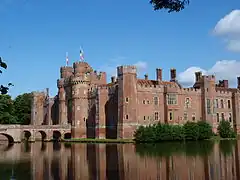Thomas Fiennes, 8th Baron Dacre
Thomas Fiennes, 8th Baron Dacre (1472 – 9 September 1534) was an English peer and soldier, the son of Sir John Fiennes.
The Lord Dacre | |
|---|---|
| Baron Dacre | |
| Coat of arms |  |
| Predecessor | Joan de Dacre, 7th Baroness Dacre |
| Successor | Thomas Fiennes, 9th Baron Dacre |
| Born | Thomas Fiennes 1472 Herstmonceux Castle, Sussex, England |
| Died | 9 September 1534 (aged 61–62) |
| Buried | All Saints Church, Herstmonceux |
| Noble family | Fiennes |
| Spouse(s) | Anne Bourchier |
| Issue |
|
| Father | Sir John Fiennes |
| Mother | Alice FitzHugh |
Career
He was born in 1472, the son of Sir John Fiennes (born c.1447, son of Richard Fiennes, 7th Baron Dacre born 1415) and Alice FitzHugh. By his mother, he was a cousin to Sir Thomas Parr, father of future queen consort Catherine Parr. He had one sister, Anne, Marchioness Berkeley (died 10 September 1497), who married secondly to Sir Thomas Brandon. On 8 March 1486, he succeeded as 8th Baron Dacre upon the death of his grandmother Joan Dacre, the suo jure 7th Baroness Dacre. He was also known as Baron Dacre of the South owing to his family seat of Herstmonceux Castle being in the county of Sussex.
In 1493, one year after his marriage, he was appointed Constable of Calais. He was invested as a Knight of the Bath in 1494. In 1497, he fought in the Battle of Blackheath where he helped defeat the Cornish.[1][2]
Marriage and issue
In about 1492, he married Anne Bourchier, the daughter of Sir Humphrey Bourchier and Elizabeth Tilney.[3] The marriage produced three sons and a daughter:[4]
- Sir Thomas Fiennes (died 26 October 1528), married in 1514, Jane Sutton, daughter of Edward Sutton, 2nd Baron Dudley, and Cicely Willoughby, by whom he had one son, Thomas Fiennes, 9th Baron Dacre and a daughter Anne who married John Mantell. The 9th Baron and his brother-in-law Mantell were hanged for the murder of John Busbridge in 1541.
- John Fiennes (b.1497)
- Thomas Fiennes
- Mary Fiennes (1495–1531), married Henry Norris, by whom she had issue.
Death
He died on 9 September 1534 at the age of 62. He was succeeded by his eldest grandson, Thomas Fiennes, as his sons had predeceased him.
The tomb set up for the 8th Baron Dacre and his son at All Saints Church, Herstmonceux, known as the Dacre Tomb,[5] is thought to have made use of effigies from an older monument intended for Thomas Hoo, Baron Hoo and Hastings (1396-1455) and his younger half-brother, also Sir Thomas Hoo (born 1416). This was shown when the monument was restored, and it was found that the original arms shown on the tabards of the figures were those of Hoo. It is conjectured that the Hoo tomb may have been at Battle Abbey, which was sold in 1539 and dismantled soon afterwards.[6][7]
Gallery
 Herstmonceux Castle, seat of the Barons Dacre of the South
Herstmonceux Castle, seat of the Barons Dacre of the South.jpg.webp) All Saints church, Herstmonceux
All Saints church, Herstmonceux Tomb of Thomas Fiennes, 8th Lord Dacre (1472–1534) and his son, Sir Thomas Fiennes (d. 1528)
Tomb of Thomas Fiennes, 8th Lord Dacre (1472–1534) and his son, Sir Thomas Fiennes (d. 1528).jpg.webp) Tomb of Lord Dacre and his son, All Saints, Herstmonceux
Tomb of Lord Dacre and his son, All Saints, Herstmonceux
Ancestry
| Ancestors of Thomas Fiennes, 8th Baron Dacre | ||||||||||||||||||||||||||||||||||||||||||||||||||||||||||||||||||||||||||||||||||||||||||||||||||||||||||||||||||||||||||||||||||||||||||||||||||||||||||||||||||||||||||||||||||||||||||||||||||||||||||||||||||||||||||||||||||||||||||||||||||||||||||||||||||||||||||||||||||||||||||||||||||||||||||||||||||||||||||||||||||||||||||||||||||||||||||||||||||||||||||||||||||||||||||||||||||||||||||||||||||||||||||||||||||||||||||||||||||||||||||||||||||||||||||||||||||||||||||||||||||||||||||||||||||||||||||||||||||||||||||||||||||||||||||||||||||||||||||||||||||||||||||||||||||||||||||||||||
|---|---|---|---|---|---|---|---|---|---|---|---|---|---|---|---|---|---|---|---|---|---|---|---|---|---|---|---|---|---|---|---|---|---|---|---|---|---|---|---|---|---|---|---|---|---|---|---|---|---|---|---|---|---|---|---|---|---|---|---|---|---|---|---|---|---|---|---|---|---|---|---|---|---|---|---|---|---|---|---|---|---|---|---|---|---|---|---|---|---|---|---|---|---|---|---|---|---|---|---|---|---|---|---|---|---|---|---|---|---|---|---|---|---|---|---|---|---|---|---|---|---|---|---|---|---|---|---|---|---|---|---|---|---|---|---|---|---|---|---|---|---|---|---|---|---|---|---|---|---|---|---|---|---|---|---|---|---|---|---|---|---|---|---|---|---|---|---|---|---|---|---|---|---|---|---|---|---|---|---|---|---|---|---|---|---|---|---|---|---|---|---|---|---|---|---|---|---|---|---|---|---|---|---|---|---|---|---|---|---|---|---|---|---|---|---|---|---|---|---|---|---|---|---|---|---|---|---|---|---|---|---|---|---|---|---|---|---|---|---|---|---|---|---|---|---|---|---|---|---|---|---|---|---|---|---|---|---|---|---|---|---|---|---|---|---|---|---|---|---|---|---|---|---|---|---|---|---|---|---|---|---|---|---|---|---|---|---|---|---|---|---|---|---|---|---|---|---|---|---|---|---|---|---|---|---|---|---|---|---|---|---|---|---|---|---|---|---|---|---|---|---|---|---|---|---|---|---|---|---|---|---|---|---|---|---|---|---|---|---|---|---|---|---|---|---|---|---|---|---|---|---|---|---|---|---|---|---|---|---|---|---|---|---|---|---|---|---|---|---|---|---|---|---|---|---|---|---|---|---|---|---|---|---|---|---|---|---|---|---|---|---|---|---|---|---|---|---|---|---|---|---|---|---|---|---|---|---|---|---|---|---|---|---|---|---|---|---|---|---|---|---|---|---|---|---|---|---|---|---|---|---|---|---|---|---|---|---|---|---|---|---|---|---|---|---|---|---|---|---|---|---|---|---|---|---|---|---|---|---|---|---|---|---|---|---|---|---|---|---|---|---|---|---|---|---|---|---|---|---|---|---|---|---|---|---|---|---|---|---|---|---|---|---|---|---|---|---|---|---|---|---|---|---|---|---|---|---|---|---|---|---|---|---|---|---|---|---|---|---|---|---|---|---|---|---|---|---|---|---|---|---|---|---|---|---|---|---|---|---|---|---|---|---|---|---|---|---|---|---|---|---|---|---|---|---|---|---|---|---|---|---|---|---|---|---|---|---|---|---|---|---|---|---|---|---|---|---|---|---|---|---|---|---|---|---|---|---|---|---|---|---|---|
| ||||||||||||||||||||||||||||||||||||||||||||||||||||||||||||||||||||||||||||||||||||||||||||||||||||||||||||||||||||||||||||||||||||||||||||||||||||||||||||||||||||||||||||||||||||||||||||||||||||||||||||||||||||||||||||||||||||||||||||||||||||||||||||||||||||||||||||||||||||||||||||||||||||||||||||||||||||||||||||||||||||||||||||||||||||||||||||||||||||||||||||||||||||||||||||||||||||||||||||||||||||||||||||||||||||||||||||||||||||||||||||||||||||||||||||||||||||||||||||||||||||||||||||||||||||||||||||||||||||||||||||||||||||||||||||||||||||||||||||||||||||||||||||||||||||||||||||||||
References
- Mosley 2003, p. 1014.
- Collins & Brydges 1812, p. 566.
- Cokayne 1916, p. 10.
- Benolte et al. 1905, p. 12.
- Image at Geograph.org.uk. Another at flickr by poundhopper1.
- Bruce & Tate 1997, pp. 6–8. (Copy held in East Sussex Record Office, Brighton, PAR399/7/2/3)
- "Monument to Thomas, 8th. Lord Dacre and Sir Thomas Fiennes". Public Sculptures of Sussex. Retrieved 29 December 2022.
- Richardson 2011, pp. 148–150.
- Cokayne 1916, p. 8.
Sources
- Benolte, Thomas; Philipot, John; Owen, George; St George, Richard (1905). Bannerman, W. Bruce (ed.). The visitations of the County of Sussex Made and Taken in the Years 1530, Thomas Benolte, Clarenceux king of arms; and 1633-4 by John Philipot, Somerset Herald, and George Owen, York Herald, for Sir John Burroughs, Garter, and Sir Richard St. George, Clarenceux. Publications of the Harleian Society. Vol. 53. London: The Harleian Society. p. 12.
- Bruce, Rosslyn; Tate, Mary H. (1997). All Saints Church, Herstmonceux. Revised and amended by Mary H. Tate. pp. 6–8. OCLC 1311285956.
- Cokayne, George Edward (1916). Gibbs, Vicary; Doubleday, H. Arthur (eds.). The Complete Peerage of England, Scotland, Ireland, Great Britain and the United Kingdom, Extant, Extinct, or Dormant. Vol. 4 (new ed.). London: St Catherine Press. pp. 9-10.
- Collins, Arthur; Brydges, Egerton (1812). Collins's Peerage of England: Genealogical, Biographical, and Historical. Vol. 6. Greatly Augmented and Continued to the Present Time, By Sir Egerton Brydges, K. J. London: Printed for F.C. and J. Rivington, Otridge and Son. OCLC 3986749.
- Mosley, Charles, ed. (2003). Burke's Peerage, Baronetage and Knightage. Vol. 1 (107th ed.). Wilmington: Burke's Peerage & Gentry. p. 1014. ISBN 0971196621.
- Richardson, Douglas (2011). Everingham, Kimball G. (ed.). Plantagenet Ancestry: A Study in Colonial and Medieval Families. Vol. 3 (2nd ed.). CreateSpace. ISBN 978-1461045137.